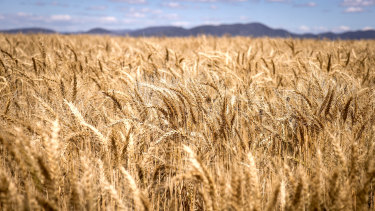
As anyone who drives is aware, petrol prices are up a lot from their 2020 low. First, the global economic recovery drove up oil demand, then Vladimir Putin’s invasion of Ukraine cut into Russian oil exports.
But prices both at the pump and at the wellhead have stabilised, at least for now. By historical standards, real gas prices — prices relative to the overall cost of living — aren’t that high; in fact, they’re lower than they were from 2006 to 2014. And as of Tuesday morning, Texas crude oil was back below $US100 a barrel.
Yet, while the energy crunch may be a bit less severe than some imagine, there’s a huge crisis in the global food supply. Indeed, over the past year the surge in wheat prices has been much bigger than the surge in oil prices. This hurts especially in poorer nations, where a much larger share of family spending goes to food. What’s behind the food crisis?

The surge in wheat prices has been much bigger than the surge in oil prices.Credit:Bloomberg
One piece of the story is obvious: Ukraine is normally a major agricultural exporter, but that’s hard to do when Russia is bombarding your railroads and blockading your ports. But there’s more to the story: Russia has halted much of its own grain exports, apparently in an attempt to hold down domestic prices. Kazakhstan, the region’s third-largest agricultural exporter, has followed suit.
Then there’s fertiliser. Modern fertiliser production is energy-intensive, and before the war, Russia was the world’s largest exporter; but Russia has now suspended those exports. Yet, it isn’t just Russia. As a new analysis by Chad Bown and Yilin Wang of the Peterson Institute for International Economics points out, China — another major fertiliser producer — cut off much of its exports last year, again in an apparent attempt to keep domestic prices down. And, as they point out, such export bans are if anything a bigger issue than the tit-for-tat tariff hikes of the US-China trade war.
All of this is causing big problems for agriculture around the world, especially in emerging markets, like Brazil. This is bad. It’s also an important lesson about the relationship between geopolitics and globalisation.
We’re often told that trade promotes peace, which may or may not be true. One thing that’s for sure, however, is that peace promotes trade.
Many people, I think, imagine that globalisation is a fairly recent development. Economic historians know, however, that a surprisingly integrated world economy emerged between about 1870 and 1913, made possible by the advanced technology of the time: steamships, railroads and telegraphs. In the early 20th century, Britons were already dining on Canadian wheat, Argentine beef and New Zealand lamb.
Then, geopolitics — wars, the rise of totalitarianism and protectionism — killed off much of this first wave of globalisation. Trade revived only with the postwar establishment of the Pax Americana, and it took around 40 years to restore world trade to 1913 levels.









 Add Category
Add Category